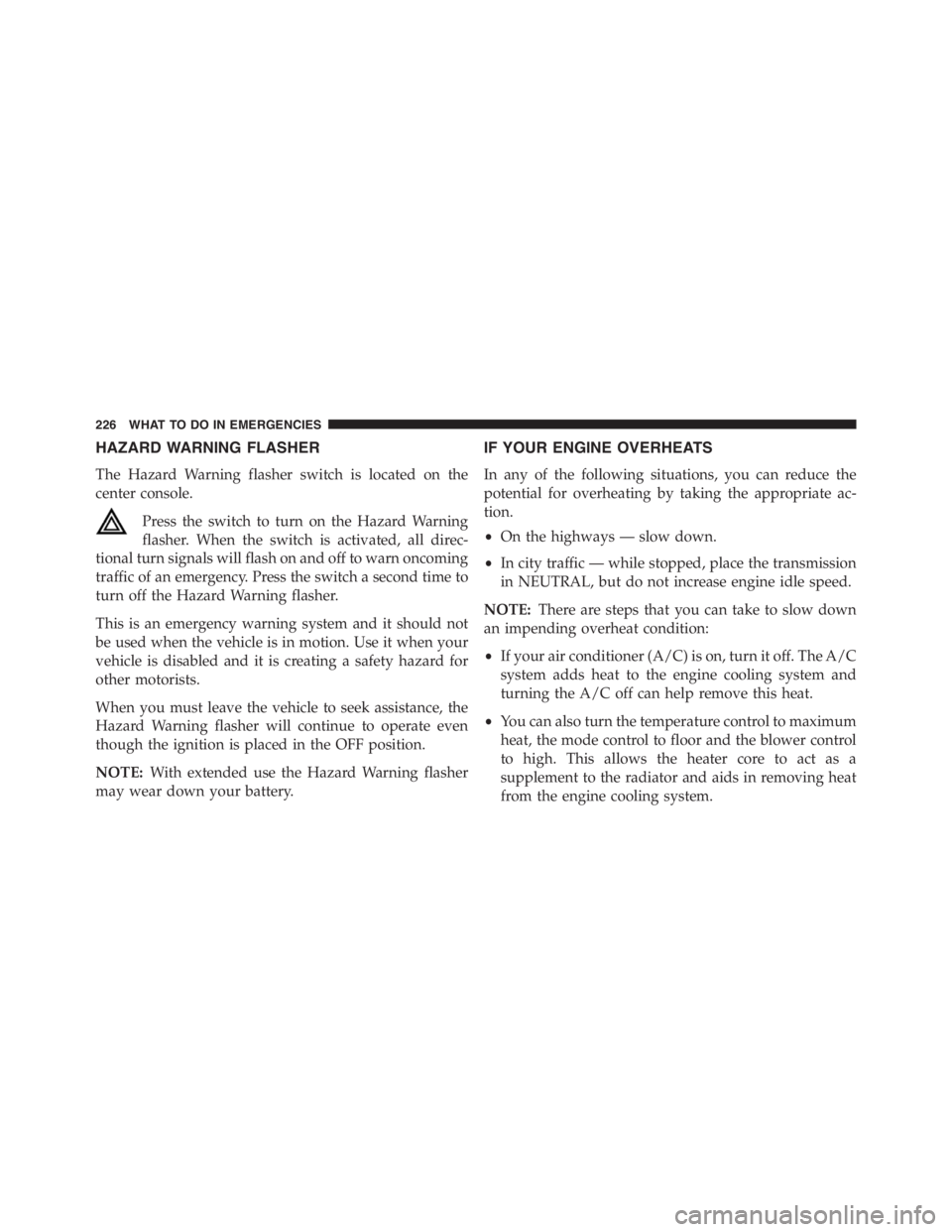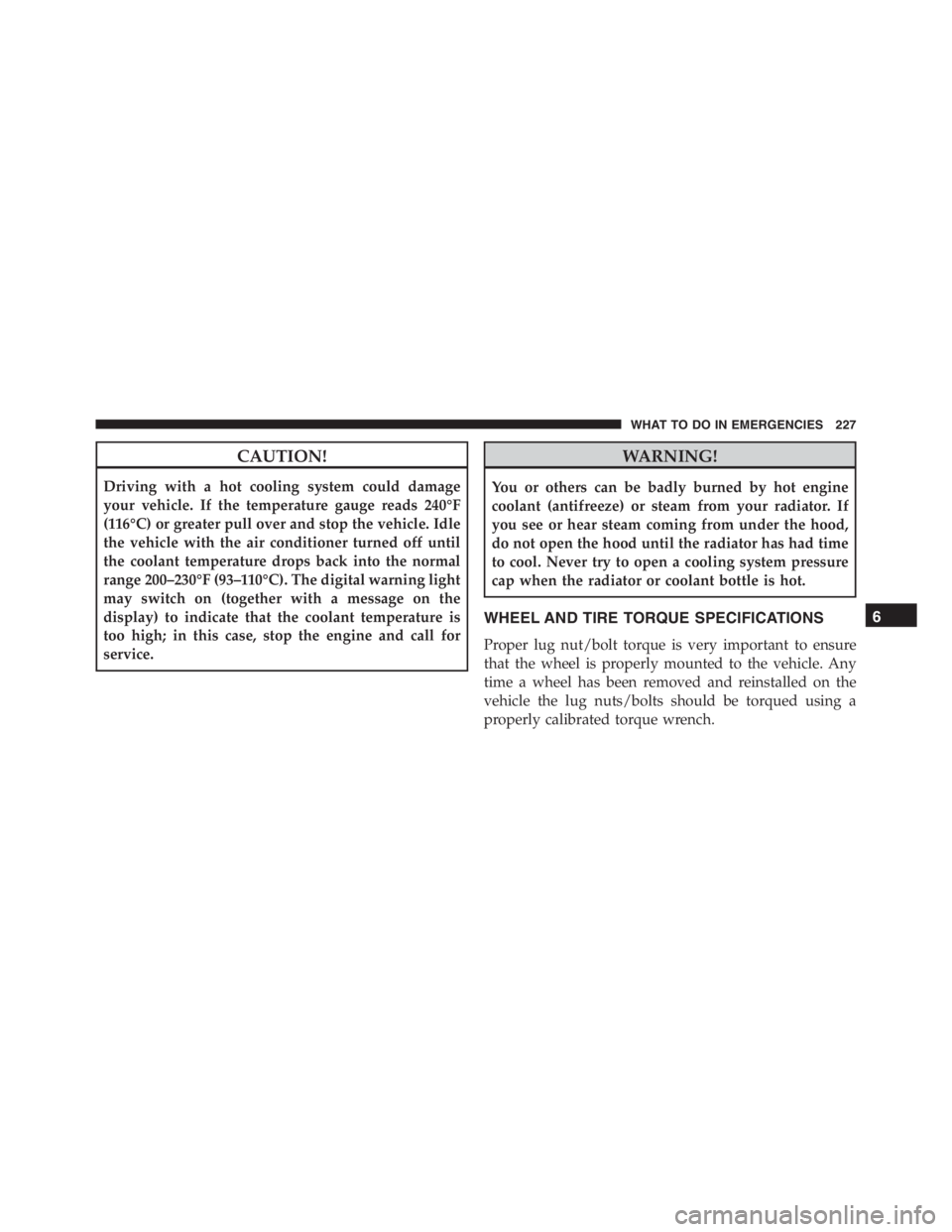Page 72 of 348

WARNING!(Continued)
•Be sure everyone in your vehicle is in a seat and
using a seat belt properly.
Exhaust Gas
WARNING!
Exhaust gases can injure or kill. They contain carbon
monoxide (CO), which is colorless and odorless.
Breathing it can make you unconscious and can
eventually poison you. To avoid breathing (CO),
follow these safety tips:
•Do not run the engine in a closed garage or in
confined areas any longer than needed to move
your vehicle in or out of the area.
(Continued)
WARNING!(Continued)
•If you are required to drive with the trunk/liftgate/
rear doors open, make sure that all windows are
closed and the climate control BLOWER switch is
set at high speed. DO NOT use the recirculation
mode.
•If it is necessary to sit in a parked vehicle with the
engine running, adjust your heating or cooling
controls to force outside air into the vehicle. Set the
blower at high speed.
The best protection against carbon monoxide entry into
the vehicle body is a properly maintained engine exhaust
system.
Whenever a change is noticed in the sound of the exhaust
system, when exhaust fumes can be detected inside the
vehicle, or when the underside or rear of the vehicle is
damaged, have a competent mechanic inspect the com-
plete exhaust system and adjacent body areas for broken,
70 THINGS TO KNOW BEFORE STARTING YOUR VEHICLE
Page 116 of 348

4. Electronic Speed Control Set Indicator Light — If
Equipped
This light will turn on when the electronic
speed control is set.
5. Temperature Gauge
The temperature gauge shows engine coolant tempera-
ture. Any reading within the normal range indicates that
the engine cooling system is operating satisfactorily.
The digital gauge will likely indicate a higher tempera-
ture when driving in hot weather, or up mountain
grades. It should not be allowed to exceed the upper
limits of the normal operating range.NOTE:Driving with a hot engine cooling system could
damage your vehicle. The digital warning light may
switch on (together with a message on the display) to
indicate that the coolant temperature is too high; in this
case, stop the engine and contact a dedicated authorized
dealership.
WARNING!
A hot engine cooling system is dangerous. You or
others could be badly burned by steam or boiling
coolant. You may want to call an authorized dealer
for service if your vehicle overheats. If you decide to
look under the hood yourself, see “Maintaining Your
Vehicle.” Follow the warnings under the Cooling
System Pressure Cap paragraph.
6. Time Display
This area of the cluster displays the time.
114 UNDERSTANDING YOUR INSTRUMENT PANEL
Page 145 of 348
HEATING AND VENTILATION
Manual Climate Controls With A/C
The Heating/Ventilation And Air Conditioning Controls
consist of a series of three rotary dials, a movable cursor
and two on/off switches.1. A/C Button
Press this button to engage the Air Conditioning. A light
will illuminate when the Air Conditioning system is
engaged.
MAX A/C
For maximum cooling, use the A/C and recirculation
modes at the same time.
ECONOMY MODE
If economy mode is desired, press the A/C switch to turn
OFF the A/C compressor. Then, rotate the temperature
control to the desired temperature.
2. Demist/Defrost Control
Press and release the Demist/Defrost Control button to
turn ON the heated outside mirrors. The Demist/Defrost
feature automatically turns OFF after 20 minutes.
Heating/Ventilation And Air Conditioning Controls
4
UNDERSTANDING YOUR INSTRUMENT PANEL 143
Page 149 of 348

Ventilation
To ventilate the passenger compartment properly, pro-
ceed as follows:
1. Fully open the vents and direct them appropriately.
2. Rotate the Temperature Control to the blue section.
3. Move the Recirculation Control to
.
4. Turn the Blower Control to the desired speed.
5. Turn the Mode Control to
.
Internal Air Recirculation Activation
•Move the Recirculation Control to.
It is advisable to switch the internal air recirculation on
while standing in queues or in tunnels to prevent the
introduction of polluted air.Do not use the function for a long time, particularly if
there are two people on board, to prevent the windows
from misting.
NOTE:The internal air recirculation system makes it
possible to reach the required heating or ventilation
conditions more quickly. Do not use the internal air
recirculation function on rainy/cold days to avoid the
possibility of the windows misting.
Climate Control
Proceed as follows:
1. Rotate the Temperature Control to the blue section.
2. Turn the Blower Control to 1 (1st fan speed). For rapid
cooling, turn Blower Control to 4 (maximum fan
speed).
4
UNDERSTANDING YOUR INSTRUMENT PANEL 147
Page 150 of 348
3. Move the Recirculation Control to.
4. Turn the Mode Control to.
5. Press the A/C button.
Cooling Adjustment
Proceed as follows:
1. Move the Recirculation Control to
.
2. Rotate the Temperature Control towards the red sec-
tion to increase the temperature.
3. Turn the Blower Control counterclockwise to reduce
the fan speed.
Door Mirror Demisting
•Press thebutton to activate this function.
•Press thebutton again to deactivate the function.
Activation is indicated by the digital warning light on the
display.
Demist/Defrost Button
148 UNDERSTANDING YOUR INSTRUMENT PANEL
Page 228 of 348

HAZARD WARNING FLASHER
The Hazard Warning flasher switch is located on the
center console.
Press the switch to turn on the Hazard Warning
flasher. When the switch is activated, all direc-
tional turn signals will flash on and off to warn oncoming
traffic of an emergency. Press the switch a second time to
turn off the Hazard Warning flasher.
This is an emergency warning system and it should not
be used when the vehicle is in motion. Use it when your
vehicle is disabled and it is creating a safety hazard for
other motorists.
When you must leave the vehicle to seek assistance, the
Hazard Warning flasher will continue to operate even
though the ignition is placed in the OFF position.
NOTE:With extended use the Hazard Warning flasher
may wear down your battery.
IF YOUR ENGINE OVERHEATS
In any of the following situations, you can reduce the
potential for overheating by taking the appropriate ac-
tion.
•On the highways — slow down.
•In city traffic — while stopped, place the transmission
in NEUTRAL, but do not increase engine idle speed.
NOTE:There are steps that you can take to slow down
an impending overheat condition:
•If your air conditioner (A/C) is on, turn it off. The A/C
system adds heat to the engine cooling system and
turning the A/C off can help remove this heat.
•You can also turn the temperature control to maximum
heat, the mode control to floor and the blower control
to high. This allows the heater core to act as a
supplement to the radiator and aids in removing heat
from the engine cooling system.
226 WHAT TO DO IN EMERGENCIES
Page 229 of 348

CAUTION!
Driving with a hot cooling system could damage
your vehicle. If the temperature gauge reads 240°F
(116°C) or greater pull over and stop the vehicle. Idle
the vehicle with the air conditioner turned off until
the coolant temperature drops back into the normal
range 200–230°F (93–110°C). The digital warning light
may switch on (together with a message on the
display) to indicate that the coolant temperature is
too high; in this case, stop the engine and call for
service.
WARNING!
You or others can be badly burned by hot engine
coolant (antifreeze) or steam from your radiator. If
you see or hear steam coming from under the hood,
do not open the hood until the radiator has had time
to cool. Never try to open a cooling system pressure
cap when the radiator or coolant bottle is hot.
WHEEL AND TIRE TORQUE SPECIFICATIONS
Proper lug nut/bolt torque is very important to ensure
that the wheel is properly mounted to the vehicle. Any
time a wheel has been removed and reinstalled on the
vehicle the lug nuts/bolts should be torqued using a
properly calibrated torque wrench.
6
WHAT TO DO IN EMERGENCIES 227
Page 249 of 348
MAINTAINING YOUR VEHICLE
CONTENTS
�ENGINE COMPARTMENT — 1.750 TURBO . . .249
�ONBOARD DIAGNOSTIC SYSTEM — OBD II . .250
�REPLACEMENT PARTS..................250
�DEALER SERVICE......................251
�MAINTENANCE PROCEDURES...........251
▫Engine Oil..........................252
▫Engine Oil Filter......................254
▫Engine Air Cleaner Filter................254
▫Engine Cover........................255
▫Maintenance-Free Battery...............256▫Air Conditioner Maintenance.............257
▫Body Lubrication.....................258
▫Wiper Blades........................259
▫Windshield Washer Nozzles..............261
▫Adding Washer Solvent.................262
▫Exhaust System......................265
▫Cooling System......................268
▫Brake System........................274
▫Alfa Twin Clutch Transmission...........278
7